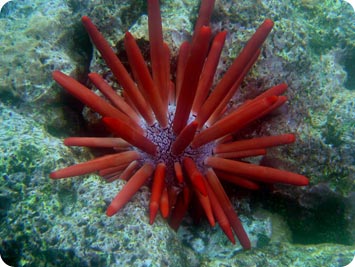 A sea urchin. Credit: National Oceanic & Atmospheric Administration.
A sea urchin. Credit: National Oceanic & Atmospheric Administration.They might not look it, but sea urchins are the underwater equivalent of Mongol hordes. Left unchecked, they can strip a kelp forest clean, leaving a barren seafloor that supports little life. That also makes them good markers of an ocean habitat’s health: too many of the spiny little critters means that something is out of whack.
Most sea urchins are no more than a few inches across. They have a hard, dome-like shell that’s covered with spines that can jab your foot if you step on them.
The urchin’s underside is covered with small tube feet that are controlled by pumping water through the body. The urchin scoots along the bottom and eats algae and dead organisms. And in fact, keeping algae in check is an important service — it keeps the algae from overrunning coral reefs and other habitats.
One of the urchin’s favorite foods, though, is kelp — green strands of seaweed. Kelp forests are an important ocean habitat. They provide food and shelter for many species of fish and other creatures.
Normally, sea urchins are kept under control by predators such as giant lobsters and sea otters. The otters crack open the shells on rocks, then put them on their bellies while they float on their backs and eat the tasty innards.
But when the number of predators drops, the urchins thrive. They can sweep across a kelp forest by the millions, wiping out entire beds in months. That kills or chases away the other creatures that live in the kelp beds — leaving a seafloor that’s almost bereft of life.

